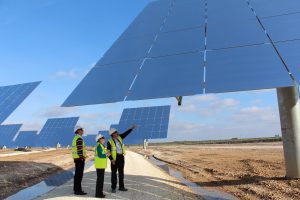Finance for sustainable development involves big numbers. Shortfalls in financing needed by developing countries to meet their sustainable development goals add up to US$2.5 trillion annually, according to the United Nations Conference on Trade and Development. Most estimates suggest US$6 trillion a year is needed for infrastructure investment, which should ideally be ‘greened’ by having low carbon goals factored in.
Whatever number one chooses, the main point is that it’s a lot of money. Making matters worse is that many sustainable development challenges are urgent for individuals and communities. We cannot wait for the `right` carbon prices, for technology costs to fall enough, or for citizens to voluntarily change their ways. We need to move money at scale, quickly, or the forces of nature will make future efforts increasingly pointless.
Conventionally, the way to finance “public works” is to use public finance – such as subsidising renewables. Yet because we are talking trillions not billions, there is simply not enough public finance to do the job. Even in China, where the state of public finances is comparatively good, at least at the national level, the People`s Bank of China estimates that public finance can only meet about 15% of green financing needs of over US$350 billion annually going forward.
Private finance is needed, and lots of it, flowing in the right direction. Global financial and capital markets currently handle over US$300 trillion in financial assets, mainly through bank lending and shares valued via stock exchanges and bonds. Today, too little of these funds are being used to finance sustainable development, and quite a lot are financing environmentally and socially unsustainable, economic activities, from dirty coal to inefficient buildings, and water and carbon-intensive agriculture. Indeed, much private finance is used for profitable short-term trading, not really touching the real economy, yet dragging much needed funds away from more productive uses.
At the same time, the owners of the world`s financial assets – citizens – are also in crisis. Today`s low interest rates mean that their savings are unlikely to deliver tomorrow`s buying power and security. The financial system is failing in its historic role of effectively connecting the owners and users of financial wealth, threatening both to impoverish generations of savers and damage the basis on which economic wealth is created, a healthy, inclusive, sustainable real economy.
So when People`s Bank of China`s Deputy Governor Yi Gang took the stage at the IMF/World Bank Annual Meetings in Lima on the 8th October, he opened a new chapter in policy debate about the future of financial and capital markets. Announcing a new workstream on green finance under China`s G20 presidency, he was not simply recognising the importance of environmental issues, but signalling the need to develop a global financial system fit for the 21st century.
Yi Gang`s comments are on the right side of history. A “quiet revolution” is taking place as growing numbers of central bankers and financial regulators take practical steps to integrate sustainable development considerations into financial market reform. These are the core findings of the UN’s two-year Inquiry into Design Options for a Sustainable Financial System, outlined in its final report, The Financial System We Want.
Developing countries have led this movement. The Indonesian Financial Services Authority has set out a ten-year “sustainable finance roadmap” covering capabilities, information, and fiscal and regulatory measures for the future. Meanwhile, Brazil`s central bank has imposed environmental risk regulations on the country`s banking community, and Kenya`s central bank has championed the introduction of mobile based payment services as a means to increase financial inclusion.
Pricing risk
South Africa has adjusted its pensions regulations to ensure that trustees take social and environmental considerations into account. The People`s Bank of China has made a series of regulatory, legal, fiscal and institutional recommendations for ‘greening’ China`s financial system that will be taken forward as part of the 13th Five Year Plan.
Some developed countries have also joined this leadership group. The Bank of England is a case in point, as is France`s recent policy measures requiring financial institutions to report on their carbon footprint and climate risks. Almost thirty stock exchanges have signed up to the Sustainable Stock Exchange Initiative committed to advancing sustainable development reporting in listing requirements. At the same time, Standard & Poor’s Ratings have incorporated climate risks into sovereign credit ratings, and guidelines have emerged to ensure continued robust growth in the issuance of green bonds.
Favourable conditions?
The financial sector, like the health or energy sectors, has an over-arching purpose – in this case, to ensure that financial flows support inclusive, sustainable prosperity. While exemplary banks or insurance companies show their leadership through social and environmental responsibility, the real task lies with policy makers, regulators and standard-setters in shaping the rules of the financial system in ways that ensures that its broader purpose can be realised.
The need to finance sustainable development is indisputable – regardless of whether this is understood through the lens of national development priorities or the need for international action in addressing global challenges, such as climate change. Fortunately, the conditions are now right for taking action.







